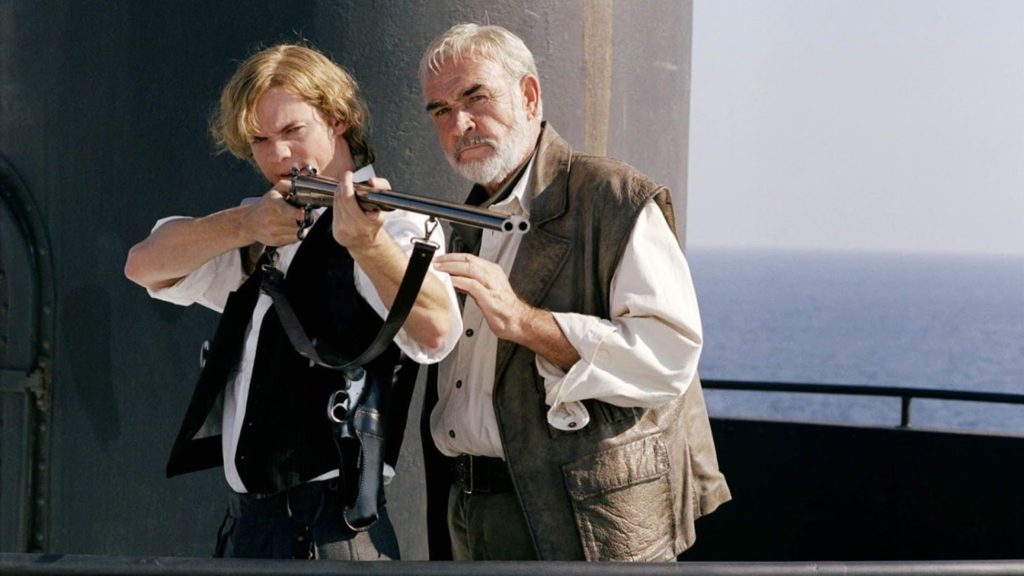The League of Extraordinary Gentlemen (2003)

Alan Moore is one of my all-time favorite writers in the world of comics. When you pick up an issue written by him, expect the unexpected, as Moore’s imagination is ceaseless, always treading the line between the mundane and the fantastic, the comical and the tragic. Most of his works pay homage to writers and styles of old, some of them in the comic book medium and others, like “The League of Extraordinary Gentlemen,” to classic Victorian-era English literature.
Although I usually buy almost any title that has Moore’s name on it, I actually skipped “League” when it was in its comic book run, leafing through it and determining it was too wordy, meant to appeal to a very small, but quite literate crowd out there, who would understand all of the multitudinous allusions Moore would toss in at every occasion. Essentially, Moore created his own superhero team utilizing already established, well-known characters in the world of literature. A novel idea, if you’ll excuse the pun.
Upon hearing of the film version being made, I thought it might be an odd little cult film, and when Sean Connery’s name became attached to it, I became much more interested, seeing that it just might be interesting after all.
Alas, I should have realized that what was once a witty, experimental homage to turn-of-the-century literary heroes would become something else entirely by the time it went through the Hollywood wringer. As the trailers emerged, it became clear that The League of Extraordinary Gentlemen, now dubbed with the gratuitous marketing title of “LXG,” is nothing more than a stripped down comic book action vehicle, with the only differences between this and say, X-Men, would be the literary origins and times of the action as set forth by Moore’s original vision.
As it plays out on the movie, the time-traveling Fantom is a criminal mastermind who sets about trying to start his own first World War, bringing back technologically advanced weaponry to 1899, and pitting countries against one another through brilliant trickery. Britain is one of the countries duped into the escalating affair, and the government has seen it necessary to call together a group of super-fighters to join the cause and try to thwart the Fantom’s efforts. The team leader is Allan Quatermain (Connery), and he’s joined by the legendary seaman, Captain Nemo (Shah, Monsoon Wedding), the vampire Mina Harker (Wilson, Mercy), the Invisible Man (Curran, The 13th Warrior), the immortal Dorian Gray (Townsend, Shade), Dr.Jekyll/Mr. Hyde (Flemyng, Below), and from America, Tom Sawyer (West, A Walk to Remember).
As I alluded to earlier, League has a very interesting premise, and a pretty good plot, if you actually manage to bother trying to follow it. Obviously, these elements pre-existed the film’s production in the comic book, so there’s no one involved in this film to attach kudos to. Giving the film some credit, it does have a decent cast of character actors, with Connery still commanding great screen presence front and center. The special effects will probably be the one element everyone will remember, as it appears that the lion’s share of the $80 million budget went to the visual effects department, with gargantuan sets, lavish costumes, mega-explosions, and loads of CGI created crafts and creatures.
There are two films which LXG reminded me a good deal of as I was watching, and considering the quality of those, I don’t think it’s anything the film’s producers would want to brag about. The first is Mystery Men, with its colorful cast of varied superheroes coming together to fight a common villain, squabbling amongst each other but still united enough as a team to save the day. Of course, this element pre-dated these films long before in superteam comics like “The Avengers”, “Justice League,” and “The X-Men,” but there is something about the costumes and way the characters interact that Mystery Men evokes that is similar here.
And speaking of “The Avengers,” this brings me to the second film that LXG reminds me of, The Avengers, which also starred Sean Connery. This was based on the television series and not the Marvel superteam comic, so the main comparison is in the production quality rather than content. Both LXG and The Avengers featured big-budget design, lots of fighting and explosions, yet rang completely hollow. They are both Hollywood misfires derived from British origin, neither of them capturing or understanding the essence of what made the other-medium counterparts so entertaining. The philosophy of both is to try to dazzle the eyes and ears as much as possible and strip out anything that would lead to better characterizations or depth in the story.
The League of Extraordinary Gentlemen is a mostly dark, violent, and sparsely engaging special effects smorgasbord, putting explosions and relentless fighting where witty dialogue and smart characterizations should be. It’s another example of small-minded, bloated budget thinking, where all inspiration is squashed under the need to play everything as dumb as can be for mass market appeal. Had they made it a modest undertaking, and adhered to the source material more closely, we might have been treated with a solid gem. Instead, the studio made a hard push to make a summer blockbuster out of the intellectual story and failed miserably in shooting for another big-name franchise. By trying to be like everyone else, The League of Extraordinary Gentlemen ends up being something all too ordinary indeed
Qwipster’s rating: D+
MPAA Rated: PG-13 for violence, language, and sexual innuendo
Running Time: 110 min.
Cast: Sean Connery, Richard Roxburgh, Stuart Townsend, Peta Wilson, Shane West, Jason Flemyng, Naseeruddin Shah, Tony Curran
Director: Stephen Norrington
Screenplay: James Dale Robinson (based on the comic by Alan Moore)
